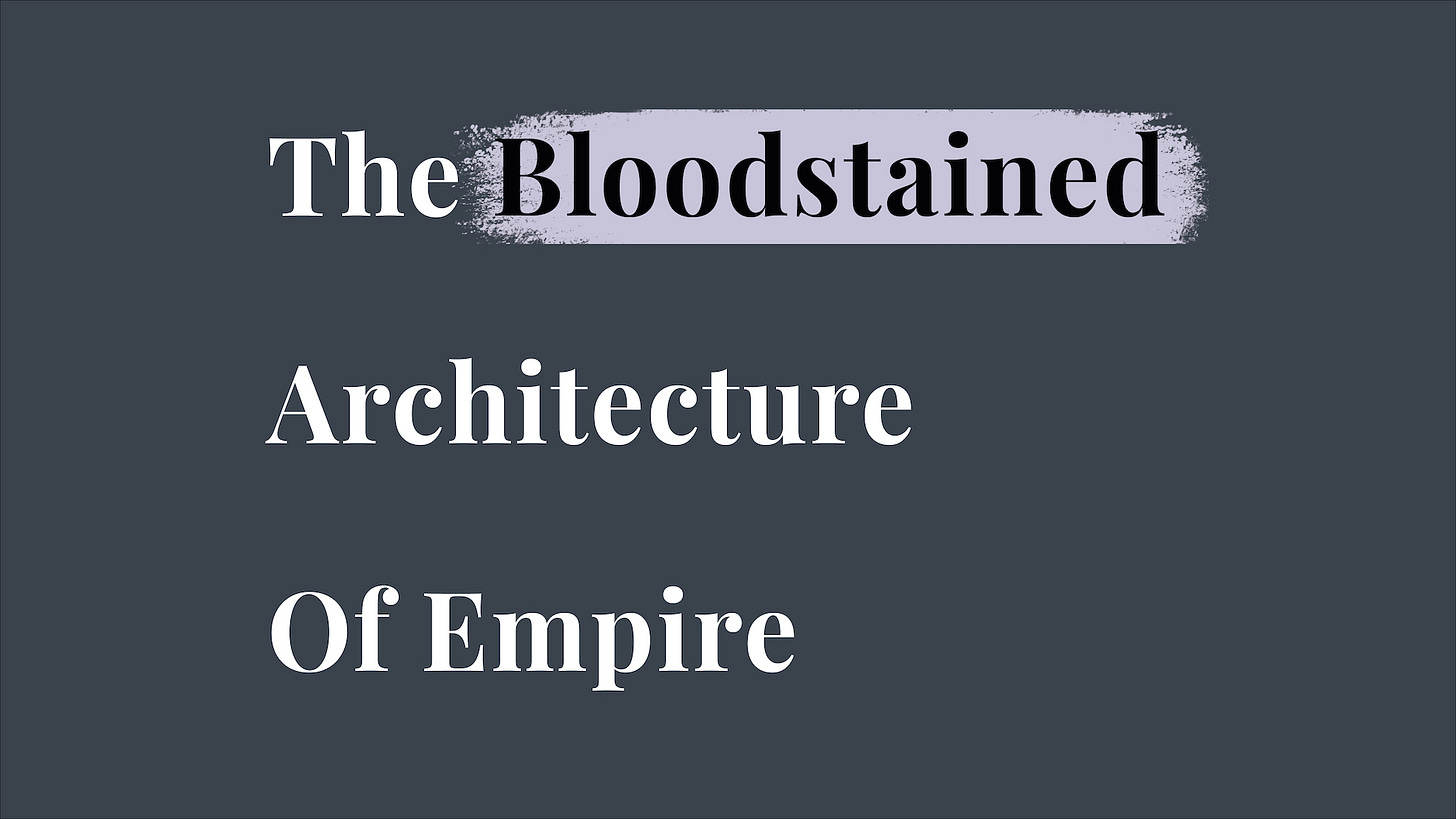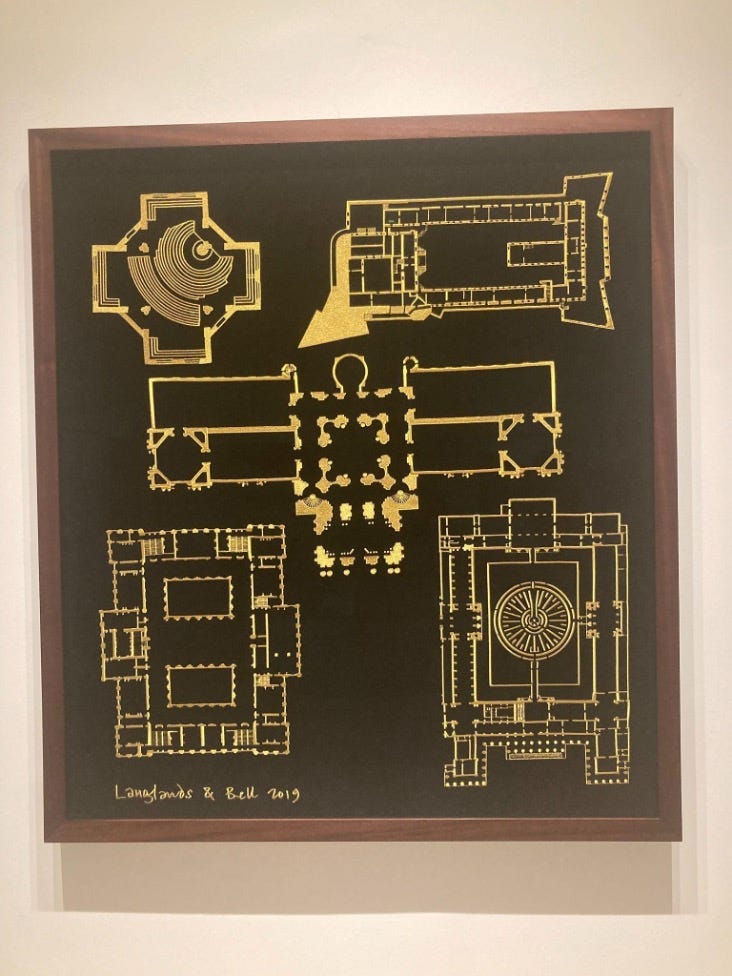Guest Post: ‘The Bloodstained Architecture Of Empire’
Written by Peter deGraft-Johnson AKA The Repeat Beat Poet (he/him)
These guest posts are free for readers, but Almaz pays all guest writers/thinkers out of her own pocket. If you enjoy this content and would like to support please consider becoming a paid subscriber of ‘She Dares to Say’. If you would prefer to make a one-off donation, feel free to also send a contribution via PayPal.
You can also show your enjoyment without spending £££, by liking, commenting or sharing 😃
[Image description: Text ‘The Bloodstained Architecture Of Empire’ on navy blue background with a lilac paintbrush stroke highlighted segment]
From May to June 2021, I returned to Ghana without my household family for the first time to undertake a writing residency at the Library Of Africa and The African Diaspora in Accra. Like many young Ghanaians born in Europe, this trip represented a new foundation of the relationship I have with Ghana. As an intelligent and invested adult and more than another immature, voiceless child hanging off a sprawling family structure; goodbye to the kids table and being paraded along the Auntie carousel and hello to Osu clubbing, political engagement, and honest writing.
The pure coincidence that the trip allowed me to escape the chokehold of a smog-filled, cultureless Lockdown London was a tasty bonus. I couldn’t wait to get back to the chin-stroking head-tilting mode of wandering round a gallery, eagerly seeking something so emotionally affecting that it holds my emotion as well as my attention.
Careful what you wish for.
Eager to return to a gallery I’d been to on my last trip to Ghana, I visited the latest exhibition from British architectural duo Langlands & Bell, called ‘The Past Is Never Dead’, at the commercial artspace ‘Gallery 1957’. The exhibit was hidden in the corner room of the noticeably empty, eerily pristine shopping mall opposite the clunkily-named five-star ‘Kempinski Hotel Gold Coast City Accra’ complex. So as I entered the exhibit, soundtracked only by the constant hum of the air conditioning and the faint rhythmic pulse of waves rolling from beyond a version of Elmina Castle’s Door Of No Return (the last door enslaved people were led through before boarding ships) that dissected the room, I stopped. I scanned the empty white-walled space (and the exhibition’s QR code), and drank in the scene.
What was I looking at?
[Image description: Needlepoint threadwork piece on with a black background and hold thread by Langlands & Bell, which is part of the ‘The Past Is Never Dead’ exhibition at commercial artspace ‘Gallery 1957’, Accra, Ghana]
The exhibition reproduces the architectural plans of forts/castles/slave dungeons/trading posts built along the Ghanaian coastline by European imperial powers since 1482, starting with Elmina Castle. The plans are almost exclusively in stark black and white. Some are constructed from needlepoint threadwork stretched over canvasses. Others are a part of the Asafo flagmaker Baaba Issaka’s tapestry that towers over the entrance featuring 20 fort silhouettes that look like Adinkra without symmetry or meaning, or unique jigsaw pieces destined to never fit a puzzle.
Enjoying ‘She Dares To Say’? Share this post with your friends
A model of Fort Jago is placed in the seat of a carved mahogany throne, upholstered with a golden plan of the castle, as a reproduction of the state chair of the last Dutch Governor of Elmina Castle. I found myself looking at the bones of imperial infrastructure, face to face with renderings of the physical monuments developed to facilitate mass human trafficking and the extraction of unimaginable wealth from Ghana. I circled the room like Joshua around Jericho in the Old Testament, visualising taking a hammer to that chair, and holding a flame beneath those canvasses. The banality and the bureaucracy of the slave economy was here in these buildings, the arrogance of colonisers was in this chair. I turned away, but a gold thread held me in place.
Directly opposite the reproduction of the Door Of No Return, complete with a room-wide projection of crashing waves, facing the coloniser’s fake throne, was another canvas. Five golden floorplans on black fabric backgrounds, in solid African redwood frames. At their centre, vaguely recognisable with its parallel wings and central hub, was the Tate Modern. To its lower right, the circular and famed Reading Room of the British Museum. Here too sat the infrastructure of European empires. Immediately the absurdity hit me. These foundational institutes of the supposedly moral English liberal democracy have their roots, their bones, their founding collections, their architectures, drenched in the crimes of empire. Every inch of their architecture is a witness to the violence of the British empire.
But why was I shocked? I was a curious British-Ghanaian poet, raised in a Ghanaian household one hour east of London. I was already preoccupied with the politics of returning, with figuring out my identity as a Ghanaian born in the imperial heartland, and how to fulfil my responsibility to actually help and not further exploit the underdeveloped continent.
However, we have a notorious unwillingness to critically engage with imperial history in Britain. The institutional denial of colonial heritage stretches throughout the British state and back into its history too, exemplified by the British Colonial Office’s ‘Operation Legacy’. As former colonies gained independence, colonial officers were ordered to burn, bury, or bring back to Britain, thousands upon thousands of documents detailing the brutal running of its colonies, to avoid the publication of the truth. In 1961, colonial secretary Iain Macleod instructed respective colonial offices to withhold the records that now belonged to the newly independent nations, knowing that their publication “might embarrass Her Majesty’s government […] the police, military forces, public servants or others e.g. police informers”.
Britain knows precisely what it is ashamed of, and however hard the government tries, the shameful legacies of imperial crimes will always be there for people to feel and see. They are indivisible from the architectures of Ghana, from the global inequality between developed and under-developed countries, from the military-industrial complex to the climate crisis, and from the echoing calls of the millions of people massacred, drowned, displaced and dehumanised under British rule.
So the question for the beneficiaries of British imperial murder and plunder is what to do now? Will Britain confront these crimes? Will we follow the wealth back to the source, force the country and its companies to take culpability and to a semblance of making amends? Will Britain accept who she is? Or will the empire on which the sun never set, carry on employing a scorched earth policy to truth, and keep on running from itself, wedded to a fabricated myth of its own colonial heritage, corrupted by an ironclad refusal to face with its own poisonous, polluting, and putrid history?
Links
‘The Past Is Never Dead’ exhibition page: privateviews.artlogic.net/2/382826d6fd8733e36c35f1
Operation Legacy: theguardian.com/uk-news/2013/nov/29/revealed-bonfire-papers-empire
Judeslist Interview w/ Langlands & Bell: open.spotify.com/episode/67P1cCvqZ3QvtKk5REb8pm?si=MEDeNDdUS4O37OQELyfa0g&dl_branch=1
[Image description: Text ‘PRODUCED BY’ on navy blue background with a lilac paintbrush stroke]
Peter deGraft-Johnson (The Repeat Beat Poet) is a British-born Ghanaian poet, broadcaster, and Hip Hop artist. He is the co-founder of the Hip Hop and Poetry open mic Pen-Ting Poetry, host of the Lunar Poetry Podcast which is archived in the British Library, and was an inaugural resident at Accra’s Library Of Africa and The African Diaspora. His debut pamphlet Testaments To Life & Death will be published in February 2022.
Links: @RepeatBeatPoet (Ko-Fi Donations page), @PenTingPoetry, @LunarPoetryPodcast
‘She Dares to Say’ is an email newsletter by Almaz Ohene, a Creative Copywriter, Freelance Journalist and Accidental Sexpert.
Follow Almaz on Twitter, Instagram, and Facebook.







